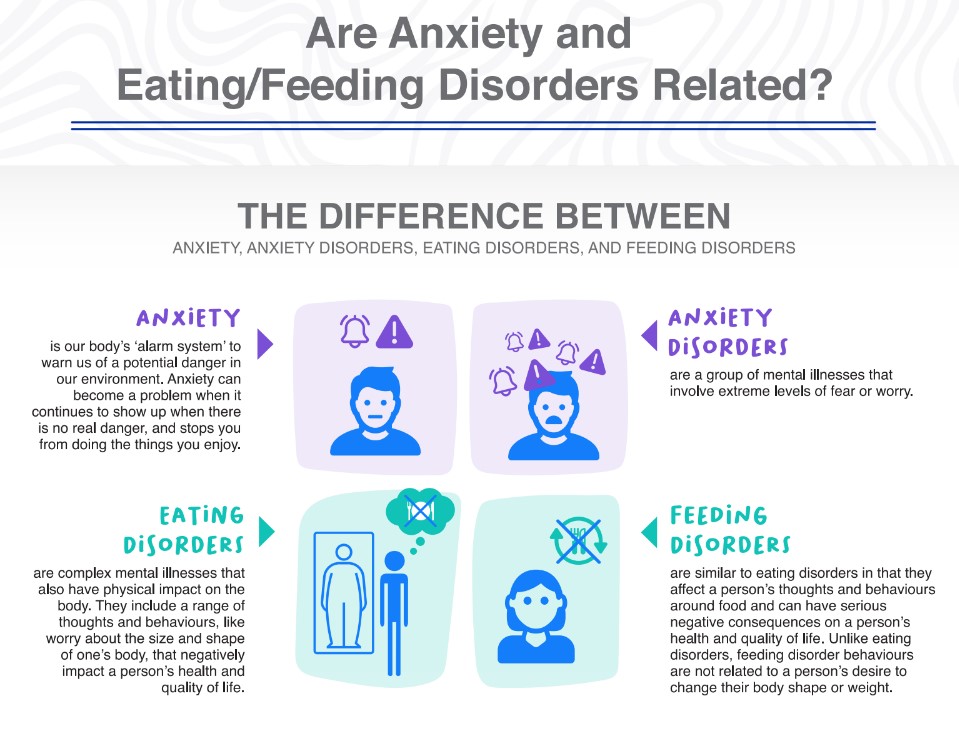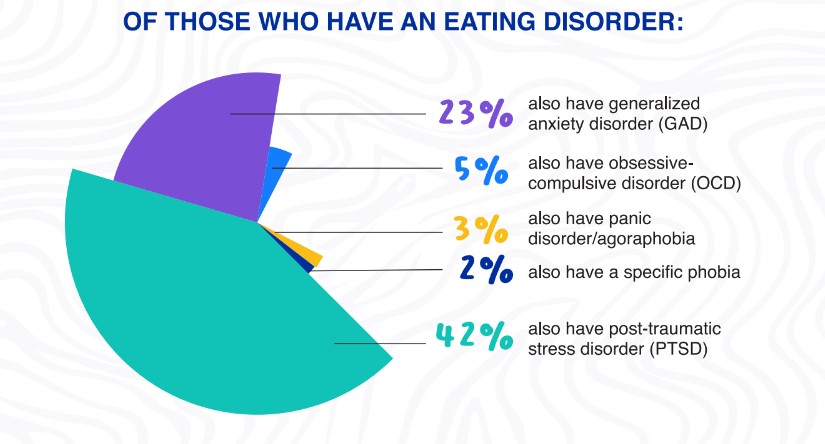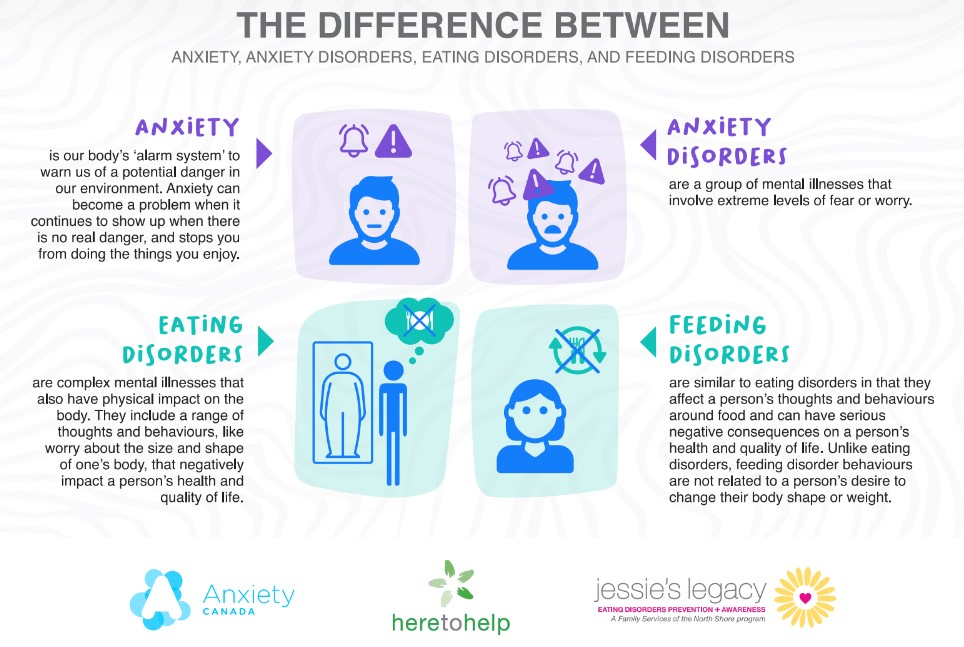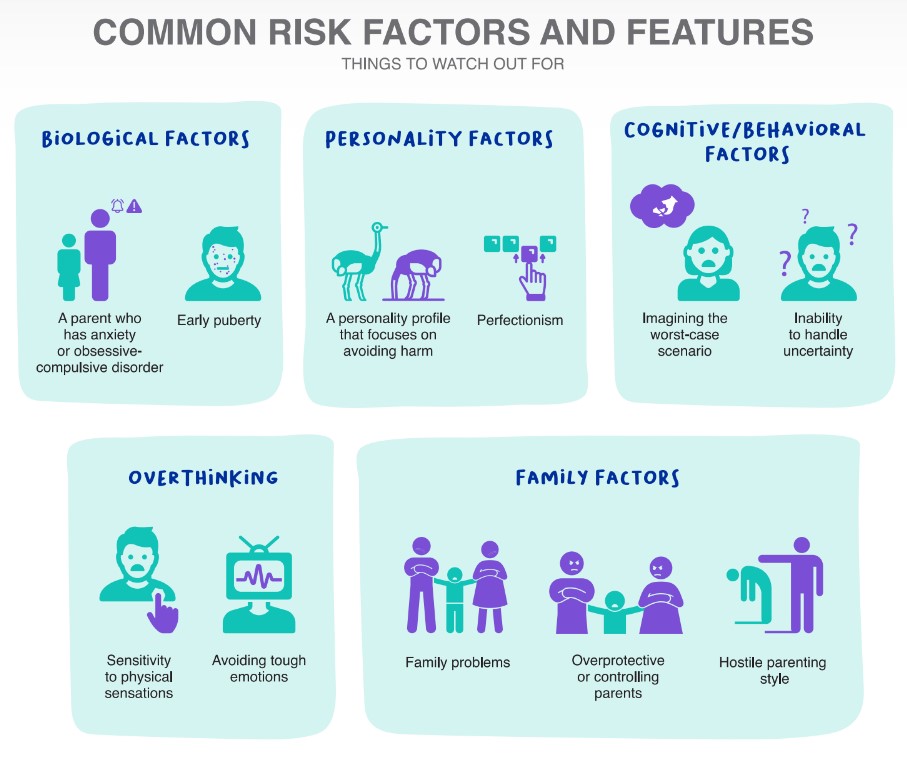The Overlap Between Anxiety and Eating Disorders
The Overlap Between Anxiety and Eating Disorders
What is anxiety?
Many people who have experienced an eating disorder or disordered eating are familiar with anxiety. It’s common to feel stuck in your head when you’re anxious and worried. In addition to worried thoughts, anxiety can show up as physical sensations in the body, including faster breathing, lightheadedness, sweating, upset stomach/nausea, and tightness in the chest.
Anxiety is our body’s ‘alarm system’ to warn us of potential danger in our environment. Everyone experiences anxiety sometimes. It’s important to remember that our body evolved this reaction to protect us from things that can threaten our survival. However, our world is much less dangerous than it once was. This means that a lot of the time our body and brain are making us think there is a serious threat when in reality there is none (or very little).
When does anxiety become a problem?
Anxiety becomes a problem when it continues to show up when there is no real danger (e.g., when your fire alarm goes off after burning toast). When anxiety happens often and is felt so strongly that it gets in the way of doing things that matter to you (e.g., getting your homework or job tasks done, socializing, making friends), it is likely there is more anxiety present than typical levels of fear and worry.
What are eating and feeding disorders?
Eating disorders are complex mental illnesses that also have a physical impact on the body. They include a range of thoughts and behaviours that negatively affect a person’s health and quality of life. Worry about the size and shape of one’s body is one of the most common features of eating disorders.
Feeding disorders are similar to eating disorders in that they affect a person’s thoughts and behaviours around food and can have serious negative consequences on a person’s health and quality of life. Unlike eating disorders, feeding disorder behaviours are not related to a person’s desire to change their body shape or weight. For example, someone with Avoidant Restrictive Food Intake Disorder (ARFID) may experience such an intense fear of choking that they find it difficult to eat enough food to maintain health and lose weight as a result.
How do anxiety, eating, and feeding disorders overlap?
- Eating and feeding disorder behaviours often develop when life challenges or struggles exceed a person’s ability to cope. During this time, feelings of stress and anxiety are common.
- In most cases (47-94% of the time), symptoms of anxiety develop before disordered eating or eating disorder symptoms show up.1
- Anxiety symptoms may be directly related to worries about food intake and/or body shape and weight but don’t have to be.
- Some common features of eating disorders that are related to anxiety symptoms include:
- Fear/worry about weight gain (common in Anorexia and Bulimia Nervosa)
- Sensitivity to physical sensations (common in Bulimia Nervosa and Feeding Disorders)
- Difficulty tolerating uncertainty (e.g., having a hard time coping when we can’t predict with a higher degree of certainty what will happen in a certain situation, or doing whatever we can to get reassurance or reduce the risk of the unwanted scenario from occurring)
- Difficulty tolerating intense emotions
- Perfectionism (e.g., the desire to do or say things perfectly, to try to make your appearance or body ‘perfect’, and experiencing stress or worry if you make a mistake or cannot reach the high standards you set for yourself.)
How common is anxiety among individuals with eating and feeding disorders?
- Studies estimate that 24-65% of individuals with an eating disorder also have an anxiety disorder.2-5
- Anxiety is very common among people with feeding disorders. For example, more than half of people with an ARFID diagnosis (avoidant and restrictive food intake disorder) also have an anxiety disorder diagnosis.6
- 13.5% of women in treatment for an eating disorder meet the requirements for an anxiety disorder.
For the full infographic version of this information, click here to view and download the PDF.






Works Cited
Anestis, M. D., Holm-Denoma, J. M., Gordon, K. H., Schmidt, N. B., & Joiner, T. E. (2008). The role of anxiety sensitivity in eating pathology. Cognitive Therapy and Research, 32(3), 370–385. https://doi.org/10.1007/s10608-006-9085-y
Bardone-Cone, A. M., Lin, S. L., & Butler, R. M. (2017). Perfectionism and Contingent Self-Worth in Relation to Disordered Eating and Anxiety. Behavior Therapy, 48(3), 380–390. https://doi.org/10.1016/j.beth.2016.05.006
Boelen, P. A., & Reijntjes, A. (2009). Intolerance of uncertainty and social anxiety. Journal of Anxiety Disorders. https://doi.org/10.1016/j.janxdis.2008.04.007
Bögels, S. M., Bamelis, L., & van der Bruggen, C. (2008). Parental rearing as a function of parent’s own, partner’s, and child’s anxiety status: Fathers make the difference. Cognition & Emotion. https://doi.org/10.1080/02699930801886706
Bögels, S., & Phares, V. (2008). Fathers’ role in the etiology, prevention and treatment of child anxiety: A review and new model. Clinical Psychology Review. https://doi.org/10.1016/j.cpr.2007.07.011
1Bulik, C. M., Sullivan, P. F., Fear, J. I., & Joyce, P. R. (1997). Eating disorders and antecedent anxiety disorders: a controlled study. Acta Psychiatrica Scandinavica, 96(2), 101–107. https://doi.org/doi:10.1111/j.1600-0447.1997.tb09913.x
Cardi, V., Leppanen, J., Mataix-Cols, D., Campbell, I. C., & Treasure, J. (2019). A case series to investigate food-related fear learning and extinction using in vivo food exposure in anorexia nervosa: A clinical application of the inhibitory learning framework. European Eating Disorders Review, 27(2), 173–181. https://doi.org/10.1002/erv.2639
Cassin, S. E., & Von Ranson, K. M. (2005). Personality and eating disorders: A decade in review. Clinical Psychology Review. https://doi.org/10.1016/j.cpr.2005.04.012
Cederlöf, M., Thornton, L. M., Baker, J., Lichtenstein, P., Larsson, H., Rück, C., … Mataix-Cols, D. (2015). Etiological overlap between obsessive-compulsive disorder and anorexia nervosa: A longitudinal cohort, multigenerational family and twin study. World Psychiatry, 14(3), 333–338. https://doi.org/10.1002/wps.20251
Drake, K. L., & Ginsburg, G. S. (2012). Family Factors in the Development, Treatment, and Prevention of Childhood Anxiety Disorders. Clinical Child and Family Psychology Review. https://doi.org/10.1007/s10567-011-0109-0
Edwards, S. L., Rapee, R. M., & Kennedy, S. (2010). Prediction of anxiety symptoms in preschool-aged children: examination of maternal and paternal perspectives. Journal of Child Psychology and Psychiatry, 51(3), 313–321. https://doi.org/doi:10.1111/j.1469-7610.2009.02160.x
Egan, S. J., Wade, T. D., & Shafran, R. (2011). Perfectionism as a transdiagnostic process: A clinical review. Clinical Psychology Review, 31(2), 203–212. https://doi.org/10.1016/j.cpr.2010.04.009
Ehrenreich-May, J., & Bilek, E. L. (2012). The Development of a Transdiagnostic, Cognitive Behavioral Group Intervention for Childhood Anxiety Disorders and Co-Occurring Depression Symptoms. Cognitive and Behavioral Practice, 19(1), 41–55. https://doi.org/https://doi.org/10.1016/j.cbpra.2011.02.003
Erol, A., Yazici, F., & Toprak, G. (2007). Family functioning of patients with an eating disorder compared with that of patients with obsessive compulsive disorder. Comprehensive Psychiatry. https://doi.org/10.1016/j.comppsych.2006.05.004
Etu, S. F., & Gray, J. J. (2010). A preliminary investigation of the relationship between induced rumination and state body image dissatisfaction and anxiety. Body Image. https://doi.org/10.1016/j.bodyim.2009.09.004
Eun, J. D., Paksarian, D., He, J.-P., & Merikangas, K. R. (2018). Parenting style and mental disorders in a nationally representative sample of US adolescents. Social Psychiatry and Psychiatric Epidemiology, 53(1), 11–20. https://doi.org/10.1007/s00127-017-1435-4
Fassino, S., Abbate-Daga, G., Amianto, F., Leombruni, P., Boggio, S., & Rovera, G. G. (2002). Temperament and character profile of eating disorders: A controlled study with the temperament and character inventory. International Journal of Eating Disorders. https://doi.org/10.1002/eat.10099
6 Fisher, M. M., Rosen, D. S., Ornstein, R. M., Mammel, K. A., Katzman, D. K., Rome, E. S., … Walsh, B. T. (2014). Characteristics of Avoidant/Restrictive Food Intake Disorder in Children and Adolescents: A “New Disorder” in DSM-5. Journal of Adolescent Health, 55(1), 49–52. https://doi.org/https://doi.org/10.1016/j.jadohealth.2013.11.013
Frank, G. K. W., Roblek, T., Shott, M. E., Jappe, L. M., Rollin, M. D. H., Hagman, J. O., & Pryor, T. (2012). Heightened fear of uncertainty in anorexia and bulimia nervosa. International Journal of Eating Disorders. https://doi.org/10.1002/eat.20929
Frost, R. O., & DiBartolo, P. M. (2004). Perfectionism, anxiety, and obsessive-compulsive disorder. In Perfectionism: Theory, research, and treatment. https://doi.org/10.1037/10458-014
Godart, N. T., Flament, M. F., Lecrubier, Y., & Jeammet, P. (2000). Anxiety disorders in anorexia nervosa and bulimia nervosa: Co-morbidity and chronology of appearance. European Psychiatry. https://doi.org/10.1016/S0924-9338(00)00212-1
Godart, Nathalie T., Flament, M. F., Curt, F., Perdereau, F., Lang, F., Venisse, J. L., …Fermanian, J. (2003). Anxiety disorders in subjects seeking treatment for eating disorders: A DSM-IV controlled study. Psychiatry Research. https://doi.org/10.1016/S0165-1781(03)00038-6
Holaway, R. M., Heimberg, R. G., & Coles, M. E. (2006). A comparison of intolerance of uncertainty in analogue obsessive-compulsive disorder and generalized anxiety disorder. Journal of Anxiety Disorders. https://doi.org/10.1016/janxdis.2005.01.002
Hudson, J. L., & Rapee, R. M. (2001). Parent–child interactions and anxiety disorders: an observational study. Behaviour Research and Therapy, 39(12), 1411–1427. https://doi.org/https://doi.org/10.1016/S0005-7967(00)00107-8
Kampman, O., Viikki, M., Järventausta, K., & Leinonen, E. (2014). Meta-analysis of anxiety disorders and temperament. Neuropsychobiology, 69(3), 175–186. https://doi.org/10.1159/000360738
Kauffman, B. Y., Shepherd, J. M., Bakhshaie, J., & Zvolensky, M. J. (2019). Anxiety sensitivity in relation to eating expectancies among college students. Journal of American College Health. https://doi.org/10.1080/07448481.2019.1656216
2Kaye, W. H., Bulik, C. M., Thornton, L., Barbarich, N., Masters, K., & Group, P. F. C. (2004). Comorbidity of anxiety disorders with anorexia and bulimia nervosa. American Journal of Psychiatry, 161(8), 2215–2221
Kerr-Gaffney, J., Harrison, A., & Tchanturia, K. (2018). Social anxiety in the eating disorders: A systematic review and meta-Analysis. Psychological Medicine, 48(15), 2477–2491. https://doi.org/10.1017/S0033291718000752
Konstantellou, A., Campbell, M., Eisler, I., Simic, M., & Treasure, J. (2011). Testing a cognitive model of generalized anxiety disorder in the eating disorders. Journal of Anxiety Disorders, 25(7), 864–869. https://doi.org/10.1016/j.janxdis.2011.04.005
Levin, M. E., MacLane, C., Daflos, S., Seeley, J. R., Hayes, S. C., Biglan, A., & Pistorello, J. (2013). Examining psychological inflexibility as a transdiagnostic process across psychological disorders. Journal of Contextual Behavioral Science, 3(3), 155–163. https://doi.org/10.1016/j.jcbs.2014.06.003
Levinson, C. A., Zerwas, S., Calebs, B., Forbush, K., Kordy, H., Watson, H., … Bulik, C. M. (2017). The core symptoms of bulimia nervosa, anxiety, and depression: A network analysis. Journal of Abnormal Psychology. https://doi.org/10.1037/abn0000254
Polivy, J., & Herman, C. P. (2002). Causes of Eating Disorders. Annual Review of Psychology, 53, 187–213.
Rost, S., Kappel, V., Salbach, H., Schneider, N., Pfeiffer, E., Lehmkuhl, U., … Sarrar, L. (2017). Psychiatric Disorders and Personality Styles in Mothers of Female Adolescent Patients with Eating Disorders. Zeitschrift Für Kinder- Und Jugendpsychiatrie Und Psychotherapie, 45(5), 361–369. https://doi.org/10.1024/1422-4917/a000495
Steinhausen, H.-C., Jakobsen, H., Helenius, D., Munk-Jørgensen, P., & Strober, M. (2015). A nation-wide study of the family aggregation and risk factors in anorexia nervosa over three generations. International Journal of Eating Disorders, 48(1), 1–8. https://doi.org/doi:10.1002/eat.22293
3Swanson, S. A., Crow, S. J., Le Grange, D., Swendsen, J., & Merikangas, K. R. (2011). Prevalence and correlates of eating disorders in adolescents: Results from the national comorbidity survey replication adolescent supplement. Archives of General Psychiatry. https://doi.org/10.1001/archgenpsychiatry.2011.22
4 Swinbourne, J., Hunt, C., Abbott, M., Russell, J., St Clare, T., & Touyz, S. (2012). The comorbidity between eating disorders and anxiety disorders: Prevalence in an eating disorder sample and anxiety disorder sample. Australian and New Zealand Journal of Psychiatry, 46(2), 118–131. https://doi.org/10.1177/0004867411432071
Taborelli, E., Krug, I., Karwautz, A., Wagner, G., Haidvogl, M., Fernandez-Aranda, F.,… Micali, N. (2013). Maternal anxiety, overprotection and anxious personality as risk factors for eating disorder: A sister pair study. Cognitive Therapy and Research, 37(4), 820–828. https://doi.org/10.1007/s10608-012-9518-8
5Ulfvebrand, S., Birgegård, A., Norring, C., Högdahl, L., & von Hausswolff-Juhlin, Y. (2015). Psychiatric comorbidity in women and men with eating disorders results from a large clinical database. Psychiatry Research. https://doi.org/10.1016/j.psychres.2015.09.008
Wildes, J. E., & Marcus, M. D. (2011). Development of emotion acceptance behavior therapy for anorexia nervosa: A case series. International Journal of Eating Disorders, 44(5), 421–427. https://doi.org/doi:10.1002/eat.20826
Woodside, D. B., Swinson, R. P., Kuch, K., & Heinmaa, M. (1996). Family functioning in anxiety and eating disorders – A comparative study. Comprehensive Psychiatry. https://doi.org/10.1016/S0010-440X(96)90575-1
Zehr, J. L., Culbert, K. M., Sisk, C. L., & Klump, K. L. (2007). An association of early puberty with disordered eating and anxiety in a population of undergraduate women and men. Hormones and Behavior. https://doi.org/10.1016/j.yhbeh.2007.06.005









